- 1864 Richmond Armory Carbine
- 1864 Richmond Shoulder Stock
- Richmond Carbine Forward Stock
- 1864 Richmond Brass Butt Plate
- 1864 Richmond Lock-plate
- 1864 Richmond Carbine Proof Marks
- Richmond Carbine Rear Sight
- Richmond Carbine Barrel Band
- Richmond Carbine Forward Barrel Band
- 1864 Richmond Carbine Front Sight
- Richmond Lock-Plate Full Cocked
- 1864 Richmond Carbine
A while back I acquired this 1864 Richmond Carbine to compliment my growing collection of Southern Weapons. I already had in my collection a 64 Richmond Carbine however it had some issues so I traded it and a 63 Richmond Carbine for a killer Thomas, Griswold & Co Artillery Saber, which I’ve recently written about.
My new 64 Richmond is about as good as it gets, the stock is in great shape with a couple of scratches and dings but nothing out of the ordinary for a 155 year old weapon. The barrel, lock plate, barrel bands and trigger guard all have a pleasing brown hue to them and the brass butt plate and the nose cap are a sweet mustard color we would expect from Southern made Brass.
Still fitted with its original rear sight (which is often missing on most Richmond weapons) with both its barrel bands having an offset U, confirming that these were hand stamped and original to the Carbine. The original ram rod is no longer present however it does have a blacksmith made ram rod which in my opinion has been with the Carbine for a long time based on its color.
All of its sling mounts have been removed, my best guess is the the sling rings were more of a hindrance then not so they were cut off……. the top barrel band, trigger guard as well as the sling swivel that gets screwed into the base of the stock are all MIA. An interesting observation is that there’s no indentation mark on the stock or on the trigger guard (where the sling mounts make contact) suggesting that the sling mounts must have been removed when the weapon was first issued.
Another interesting observation is there is only a partial proof mark on the barrel, the V for viewed is clearly present and there’s a very slight impression of the P for proof but there’s no Eagle present. I don’t believe this to be a confiscated condemned Harper’s Ferry barrel…….it has way to many imperfections on the barrel made by the barrel roller machine, these imperfections would not be acceptable by Harper’s Ferry standards, however they would be by Richmond’s Armory standards.
There you have it another Southern Carbine brought to you by the Civil War Arsenal. If you have any questions about this weapon or any of the other weapons in my arsenal feel free to contact me at civilwararsenal@yahoo.com attn: Gene West.

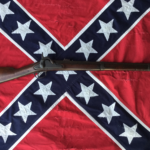
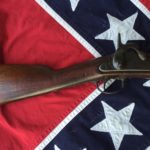
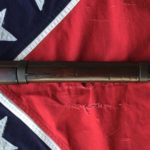
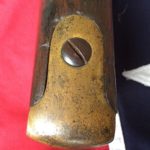
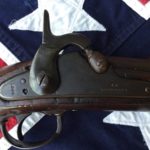
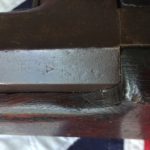
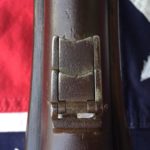
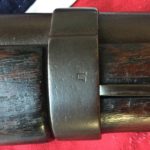
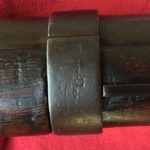
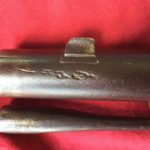
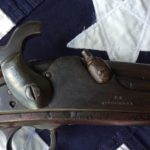
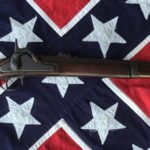
Hello Mr. West,
First off, let me tell you how much I enjoy your postings on CS weapons, particularly the Richmond Carbines.
I have had a possible Richmond Carbine in my collection for quite awhile but over the years I have questioned whether it is the “real McCoy.”
Overall fit and finish look good. It has all of the correct dimensions (e.g., 40 1/2″ overall, 25″ barrel, .58 caliber, three broad lands and grooves) plus a US marked iron buttplate, screw-in swivel midway between the lock and butt, 1862 Richmond lock, barrel only with VP marks, unmarked iron triggerguard with the swivel bolster ground off, classic CS barrel bands with the off-set “U” marking, brass nosecap,and original looking ramrod. The two swivels are attached with rivets rather than screws.
To the negative side is a “too new” looking rear sight and a repair to the stock at the front band. The wood used for the repair looks consistent in age and grain with the remainder of the stock. The quality is good (not a “Bubba job”) though any stock “stretching” always makes me dubious.
Strangely, in the upper 2/3’s of the barrel channel it looks like some type of soft metal (like lead, tin, antimony, etc) has been dripped in to the channel in increasingly smaller drops as the material approaches the muzzle. I have tried to scratch this substance with a pretty hard scribe and I can only make minor scratches. The material extends in the barrel channel up to the nosecap.
I didn’t pay much for the item and with the value of the lock and bands, I certainly would not be in a hole if this turns out to be a bogus item.
My reason for contacting you today is to impose on your time and ask you to look at the attached picture of the gun’s lock recess. I viewed with interest your collection of pictures of Richmond lock recesses. I am hoping that you might be able to give me some impressions re this carbine that I am questioning.
Thanks in advance for your time and keep up the great work!
Max
Max,
It’s impossible to tell if something is correct with one picture, however my first impression is the sharp edges around the lock plate cavity doesn’t seem consistent with any Richmond Carbine I’ve handled.
If you look at the five Carbine stocks in the picture to follow you will see that all of them “do not” have sharp edges…..they’ve been sanded smooth………I’ve handled many other original Richmond Carbines and all are as the picture below…..none have sharp edges.
Id be interested in seeing more pictures of the weapon. Including barrel, lock plate, barrel bands, nose cap, butt plate, and additional pictures of the stock.
Regards, Gene
Hello Again Gene,
Thanks so much for your help on this odd ball gun. My feeling is that it is comprised of a few legitimate CS parts (lock, barrel bands, nose cap dthough I am no expert on these), a barrel of US origin (V P and remnants of eagle head…also a free-hand chiseled “W or M” on the top of the barrel at the breech) but of otherwise unknown provenance and a Model 1855 or 1861 cut-down musket stock (no marks except some undetermined letter in the triggerguard channel). With what appears to also be 1855/61 buttplate (US marked, I was unable to take it off) and triggerguard (no marks).
For your reference files, I will include some pictures that I took today. Let me know what you think these pix might tell us about the gun.
Lock front: appears to standard 1862 and CS/Richmond, VA marks.
Lock reverse: nothing unusual noted and no marks evident (I didn’t disassemble)
Barrel bands: the “U” marks line up about an 1/8th of an inch above (i.e. toward the barrel) the retainer springs
Nose cap: appears to be brass or bronze but your expertise is required to truly identify
Front sight and muzzle (two pictures): please see the pictures on these items…the muzzle appears really beat up so my question is did that occur in service or did it accompany a more recent shortening effort?
Barrel channel, unknown foreign substance and grafted piece: these pictures show what appears to be old varnish or some oxidized metal which is so hard that I really have to “lean into it” to get a carbide scribe to make any cuts. These pictures also show the grafted piece above the upper band. Note the gap between the end of the grafted wood and the nose cap.
Ramrod (no picture): very little threading and rod is thicker than any of my 1855 or 1861 rifle muskets also the head appears to have been welded on
“W or M” mark on top of barrel at breech: deeply applied freehand so a chisel of some sort would probably have been used
“Grind Marks” on top of barrel at each band: as if this piece didn’t already have enough oddities, please note these weird findings
Gene, I really appreciate your taking the time to look at this curiosity. When I got it from John Spicer in Mississippi a number of years ago, I didn’t think to do a disassembly since I didn’t have that much in it. Now that I have torn it down and have all of these questions, I have tried several times to reach John but have not been able to do so. His website is no longer in existence and several relic/CW item guys in the AL and MS area haven’t heard of him in some time. I will keep trying to reach him and if I am able to locate him to get some answers, I will share these with you.
Due to the email load of a number of pictures, I will send the attachments in several installments.
Thanks again and best regards,
Max